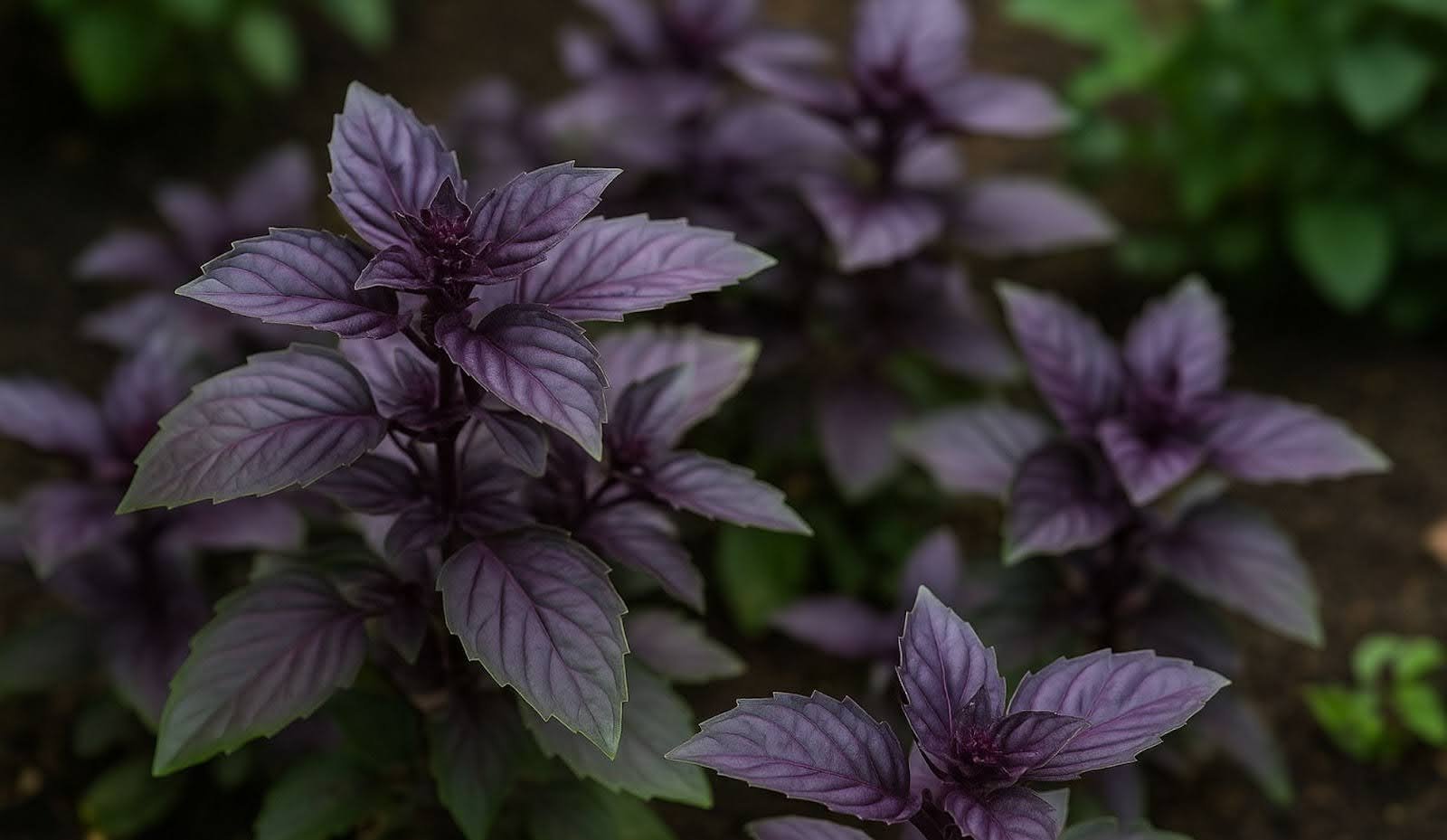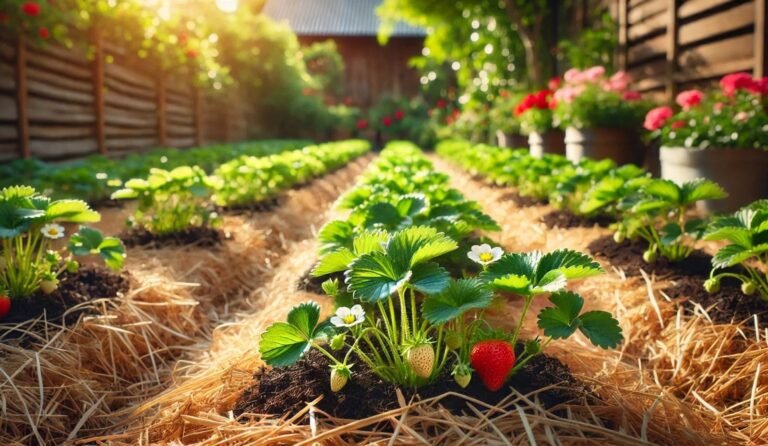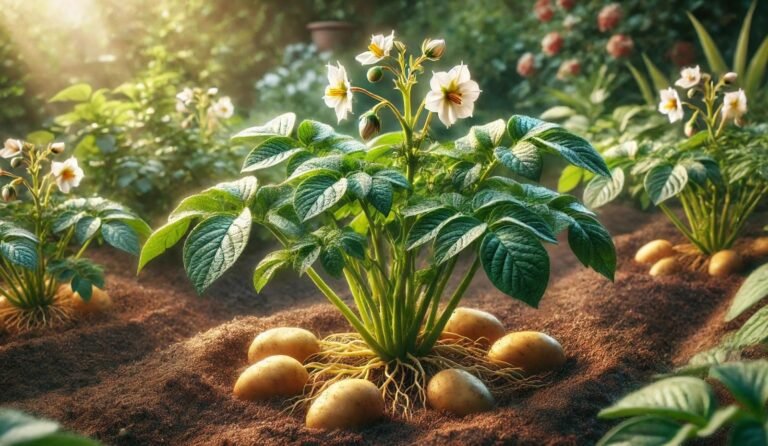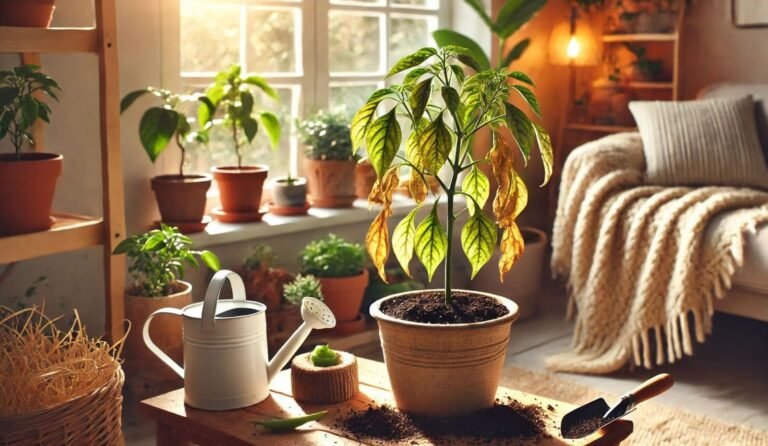Purple Basil Plants: Harvesting Tips for Maximum Flavor
Purple basil plants aren’t just pretty—they’re a whole vibe. With their deep violet leaves and punchy, slightly spicy flavor, they’ll have your garden looking next-level and your kitchen smelling amazing. If you’re used to the basic green basil, this is your chance to shake things up with something way more eye-catching (and honestly, tastier too).
The best part? These beauties are surprisingly low-maintenance and can thrive both in your backyard or right on your kitchen counter. Whether you’re a gardening newbie or just want to grow something that doubles as a conversation starter, purple basil is it. Stick around—we’re diving into everything you need to know to grow, use, and fall a little in love with this bold herb.
What Is Purple Basil Plant and Why Is It So Stunning?
Purple basil plant, scientifically known as Ocimum basilicum ‘Purpurascens’, is a variety of sweet basil known for its rich, dark purple leaves and slightly more pungent, peppery taste. That purple color comes from anthocyanins—the same kind of antioxidants found in blueberries and red cabbage. So not only does it look beautiful, but it also offers some impressive health benefits, too.
There are a few popular varieties, each with their own flair. ‘Dark Opal’ is probably the most well-known, with its glossy leaves and subtle clove-like flavor. ‘Purple Ruffles’ adds a little texture with frilly, almost ornamental leaves and a hint of anise.
Then there’s ‘Red Rubin’, a newer cultivar with larger leaves and a bold, spicy kick. And let’s not forget ‘African Blue Basil’, a perennial variety with purple-green leaves and a scent that’s a cross between camphor and clove. It’s a magnet for bees and butterflies, too.
No matter the variety, purple basil tends to be just as versatile as green basil, but it brings something extra to the table—literally and figuratively.
Why Should You Grow Purple Basil Plants?
There are so many reasons to make purple basil plants a regular guest in your garden or kitchen. First off, let’s talk about looks. Its deep purple leaves are an immediate eye-catcher, adding a sense of luxury and depth wherever it grows. Tuck it in between your tomatoes, let it peek out of a window box, or grow it in a pot on your windowsill—it’ll always steal the show.
Beyond appearances, purple basil is a culinary gem. It offers a flavor profile that’s similar to sweet basil, but with a little extra warmth and spice. Some varieties lean slightly toward anise or clove, making them especially fun to experiment with in both savory and sweet dishes.
And then there’s the health side. Because of those anthocyanins, purple basil contains more antioxidants than green basil. Add that to its antibacterial and anti-inflammatory properties, and you’ve got yourself a tasty little wellness booster.
Purple basil is also a natural pest deterrent. The strong aroma repels aphids, mosquitoes, and even the dreaded tomato hornworm. That makes it a great companion plant for tomatoes, peppers, and eggplant. It’s pretty, tasty, and protective—what more could you ask for?
How to Grow Purple Basil (It’s Easier Than You Think)
Whether you’ve got a sunny yard, a small patio, or just a bright kitchen window, purple basil is happy to grow just about anywhere—so long as it gets enough sun and warmth.
Outdoors, basil thrives in full sun. Look for a spot that gets at least six hours of sunlight per day, though eight or more is ideal for the richest purple color. Purple basil doesn’t like cold, so wait until all danger of frost has passed before planting it outside. If nighttime temps are still dipping below 50°F (10°C), keep it indoors a little longer.
Soil-wise, the purple basil plant is a bit picky. It loves rich, loamy, well-drained soil. If you’re planting it in the ground, mix in some compost or aged manure to give it a nutrient boost. For containers, choose a high-quality potting mix and make sure your pot has good drainage. Soggy roots are basil’s worst nightmare.
Indoors, it’s just as easy to grow. All you need is a bright south-facing window, or a grow light if your space is a little dim. Make sure to turn the plant regularly if it’s leaning toward the light. Use a container with drainage holes, water when the top inch of soil is dry, and keep it somewhere warm and draft-free. That’s it!
Starting from Seeds or Cuttings
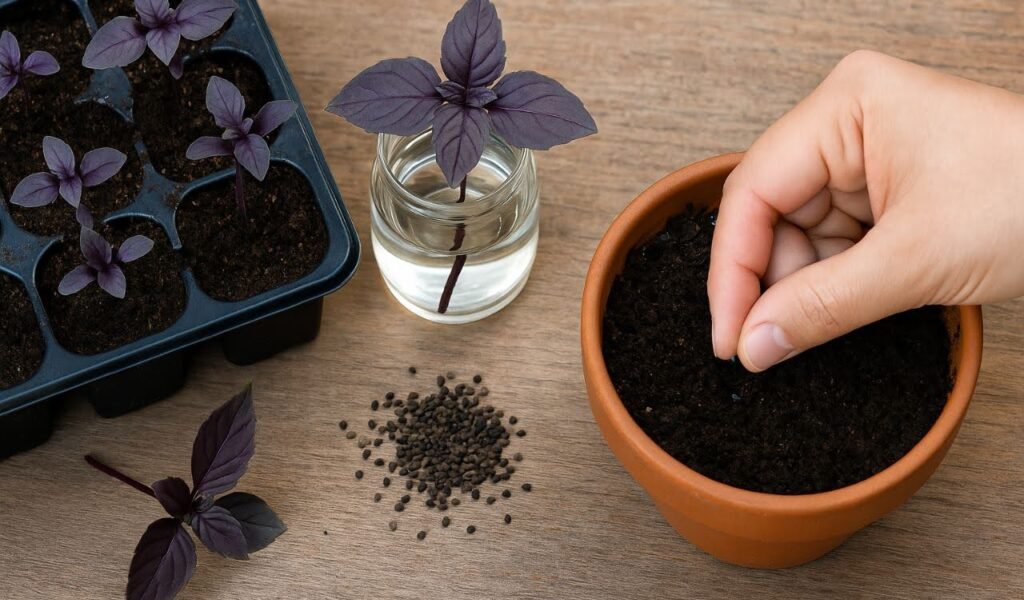
If you’re starting from seeds, sow them indoors about 6 to 8 weeks before your last expected frost date. Basil seeds are tiny, so just press them lightly into a moist seed-starting mix and keep them warm—around 70°F (21°C) is perfect. They’ll usually sprout in 5 to 10 days. Once they’ve got a couple sets of true leaves and the weather is warm, they’re ready to move to the garden or a bigger pot.
But here’s a cool trick: purple basil plants are super easy to grow from cuttings. Just snip a 4–6 inch stem right below a leaf node, strip off the bottom leaves, and pop it in a glass of water. Within a week or so, you’ll see roots sprouting. Once the roots are a couple inches long, you can pot it up and start your new plant. It’s a great way to keep your basil going all year.
Caring for Purple Basil Plants Like a Pro
Purple basil is relatively low-maintenance, but there are a few golden rules to get the most from your plant.
First, water deeply but not too often. Let the top inch of soil dry out before watering again. Consistent moisture is important, especially for container-grown plants, but overwatering can cause root rot or fungal issues.
Second, feed it! Basil loves a little snack now and then. Use a balanced liquid fertilizer every month or so during the growing season, or just top-dress with compost if you’re growing organically.
And most importantly—prune early and often. The more you pinch, the more your basil will grow. Start pruning when your plant has about six sets of leaves. Always cut just above a pair of leaves to encourage branching. Regular pruning keeps the plant full and prevents it from going to seed (which can make the leaves bitter).
If you see flower buds forming, pinch them off unless you’re growing it for pollinators or want to collect seeds. Basil flowers are pretty, but once the plant blooms, it stops focusing on leaf production.
Harvesting and Enjoying the Fruits of Your Labor
Harvesting purple basil is super satisfying—and the more you harvest, the more it grows. Snip stems in the morning when the oils are strongest, and avoid taking more than a third of the plant at once. Be gentle with your cuts, and use clean scissors or pruners to avoid stressing the plant.
Fresh basil can be stored on your counter in a glass of water like a bouquet, which honestly looks as pretty as any floral arrangement. For longer-term storage, you can freeze it in olive oil or make herb butter cubes. Drying is also an option, though you may lose some of the beautiful color and delicate flavor in the process.
Purple Basil in the Kitchen: Endless Possibilities
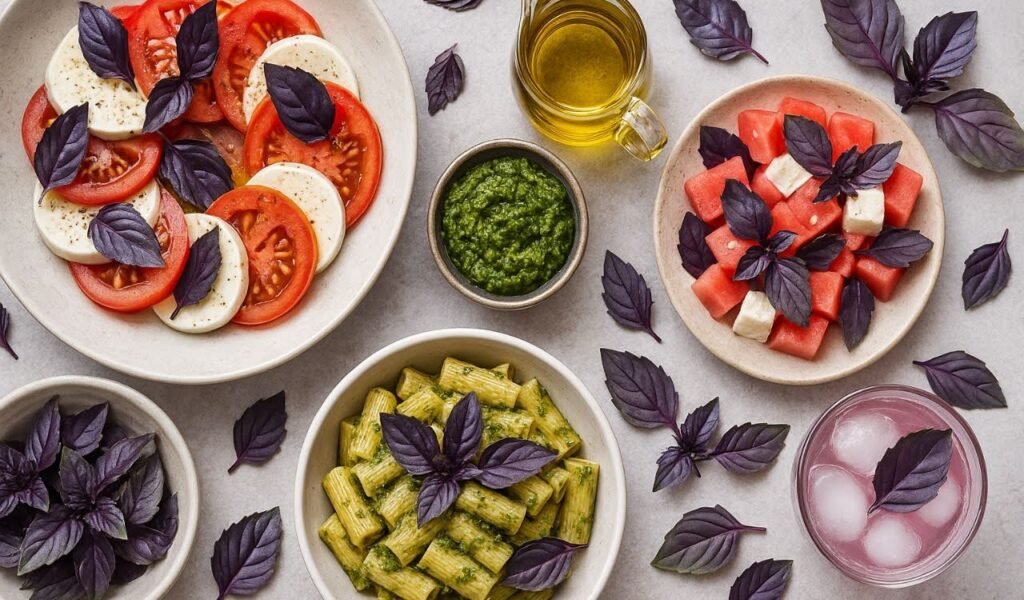
Let’s talk about the fun part—eating it! A purple basil plant can be used just like green basil in most recipes, but its flavor and color shine in certain dishes.
It’s fantastic in salads, where it adds a surprising pop of color. Try it layered with heirloom tomatoes and fresh mozzarella for a vibrant caprese. Or chop it into a watermelon and feta salad for a summer dish that tastes as good as it looks.
You can also use it to make a vivid purple pesto—just swap out green basil for purple in your favorite recipe. The result is slightly spicier and incredibly beautiful. Add it to pasta, spread it on sandwiches, or use it as a pizza base.
If you’re into drinks, muddle it into cocktails or iced tea. Purple basil lemonade is a personal favorite—it turns a lovely pinkish-purple and tastes divine. You can even infuse it into vinegar or oils for a gourmet touch.
Common Mistakes and How to Avoid Them
Every gardener slips up now and then, but a few tweaks can make your purple basil experience a breeze. Don’t overwater—let the soil dry out a bit between waterings. Make sure your plant gets enough sunlight, especially indoors, or it might turn green and leggy. And don’t forget to pinch regularly—neglecting to prune is the fastest way to a tall, scraggly plant that wants to flower too soon.
Also, don’t crowd your basil. Airflow is important for keeping mildew at bay. And if pests show up, treat early with organic solutions like neem oil or insecticidal soap.
FAQ
Can I grow purple basil plants indoors?
Yes! They grow well indoors with plenty of sunlight or a good grow light.
How is purple basil different from green basil?
It has a slightly spicier flavor and contains more antioxidants, thanks to its anthocyanins.
Why is my purple basil turning green?
Lack of sunlight is the most common cause. Move it to a sunnier spot.
Can I eat purple basil just like green basil?
Absolutely! It’s great in salads, pesto, pasta, and even drinks.
How often should I water purple basil plants?
Water when the top inch of soil is dry—don’t let the roots sit in water.
Can I grow new plants from purple basil cuttings?
Yes! Just root cuttings in water and transplant when roots appear.
When should I harvest purple basil for the best flavor?
In the morning, once the plant is 6–8 inches tall. Pinch regularly to promote growth.
Final Thoughts
Purple basil plants are more than just a pretty face. It’s a flavor-packed, antioxidant-rich, pollinator-friendly plant that adds a splash of color to your meals and your life. Whether you’re growing it for the first time or adding it to an established herb collection, it’s sure to bring beauty and joy to your gardening journey.
With a little sun, some regular love, and a few snips here and there, you’ll have a thriving, fragrant plant that keeps giving all season long—and probably inspires a few “What plant is that?!” questions from friends and neighbors. So go ahead—grab some seeds, dig into the soil, and let purple basil add a little drama and delight to your growing space.

